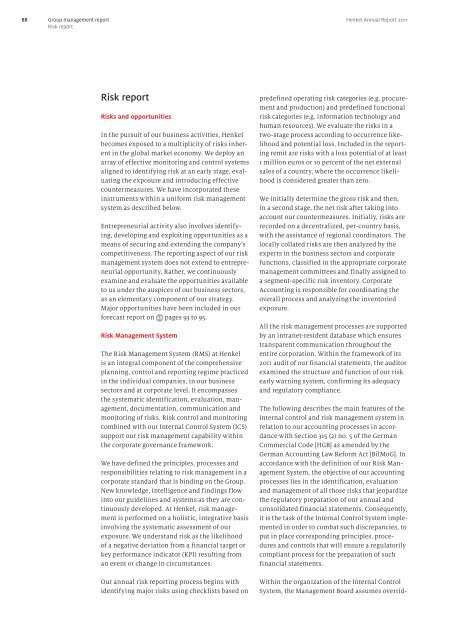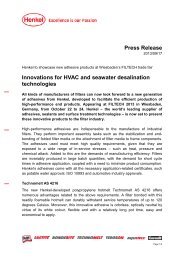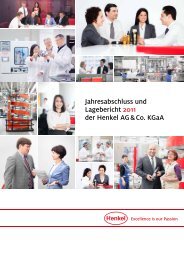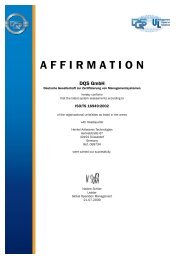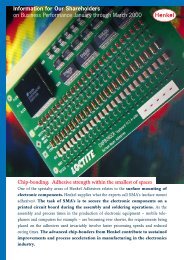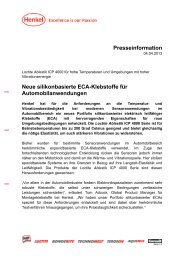Henkel Annual Report 2011 - Henkel AG & Co. KGaA Annual Report ...
Henkel Annual Report 2011 - Henkel AG & Co. KGaA Annual Report ...
Henkel Annual Report 2011 - Henkel AG & Co. KGaA Annual Report ...
You also want an ePaper? Increase the reach of your titles
YUMPU automatically turns print PDFs into web optimized ePapers that Google loves.
88 Group management report<br />
Risk report<br />
<strong>Henkel</strong> <strong>Annual</strong> <strong>Report</strong> <strong>2011</strong><br />
Risk report<br />
Risks and opportunities<br />
In the pursuit of our business activities, <strong>Henkel</strong><br />
becomes exposed to a multiplicity of risks inherent<br />
in the global market economy. We deploy an<br />
array of effective monitoring and control systems<br />
aligned to identifying risk at an early stage, evaluating<br />
the exposure and introducing effective<br />
countermeasures. We have incorporated these<br />
instruments within a uniform risk management<br />
system as described below.<br />
Entrepreneurial activity also involves identifying,<br />
developing and exploiting opportunities as a<br />
means of securing and extending the company’s<br />
competitiveness. The reporting aspect of our risk<br />
management system does not extend to entrepreneurial<br />
opportunity. Rather, we continuously<br />
examine and evaluate the opportunities available<br />
to us under the auspices of our business sectors,<br />
as an elementary component of our strategy.<br />
Major opportunities have been included in our<br />
forecast report on pages 93 to 95.<br />
Risk Management System<br />
The Risk Management System (RMS) at <strong>Henkel</strong><br />
is an integral component of the comprehensive<br />
planning, control and reporting regime practiced<br />
in the individual companies, in our business<br />
sectors and at corporate level. It encompasses<br />
the systematic identification, evaluation, management,<br />
documentation, communication and<br />
monitoring of risks. Risk control and monitoring<br />
combined with our Internal <strong>Co</strong>ntrol System (ICS)<br />
support our risk management capability within<br />
the corporate governance framework.<br />
We have defined the principles, processes and<br />
responsibilities relating to risk management in a<br />
corporate standard that is binding on the Group.<br />
New knowledge, intelligence and findings flow<br />
into our guidelines and systems as they are continuously<br />
developed. At <strong>Henkel</strong>, risk management<br />
is performed on a holistic, integrative basis<br />
involving the systematic assessment of our<br />
exposure. We understand risk as the likelihood<br />
of a negative deviation from a financial target or<br />
key performance indicator (KPI) resulting from<br />
an event or change in circumstances.<br />
Our annual risk reporting process begins with<br />
identifying major risks using checklists based on<br />
predefined operating risk categories (e.g. procurement<br />
and production) and predefined functional<br />
risk categories (e.g. information technology and<br />
human resources). We evaluate the risks in a<br />
two-stage process according to occurrence likelihood<br />
and potential loss. Included in the reporting<br />
remit are risks with a loss potential of at least<br />
1 million euros or 10 percent of the net external<br />
sales of a country, where the occurrence likelihood<br />
is considered greater than zero.<br />
We initially determine the gross risk and then,<br />
in a second stage, the net risk after taking into<br />
account our countermeasures. Initially, risks are<br />
recorded on a decentralized, per-country basis,<br />
with the assistance of regional coordinators. The<br />
locally collated risks are then analyzed by the<br />
experts in the business sectors and corporate<br />
functions, classified in the appropriate corporate<br />
management committees and finally assigned to<br />
a segment-specific risk inventory. <strong>Co</strong>rporate<br />
Accounting is responsible for coordinating the<br />
overall process and analyzing the inventoried<br />
exposure.<br />
All the risk management processes are supported<br />
by an intranet-resident database which ensures<br />
transparent communication throughout the<br />
entire corporation. Within the framework of its<br />
<strong>2011</strong> audit of our financial statements, the auditor<br />
examined the structure and function of our risk<br />
early warning system, confirming its adequacy<br />
and regulatory compliance.<br />
The following describes the main features of the<br />
internal control and risk management system in<br />
relation to our accounting processes in accordance<br />
with Section 315 (2) no. 5 of the German<br />
<strong>Co</strong>mmercial <strong>Co</strong>de [HGB] as amended by the<br />
German Accounting Law Reform Act [BilMoG]. In<br />
accordance with the definition of our Risk Management<br />
System, the objective of our accounting<br />
processes lies in the identification, evaluation<br />
and management of all those risks that jeopardize<br />
the regulatory preparation of our annual and<br />
consolidated financial statements. <strong>Co</strong>nsequently,<br />
it is the task of the Internal <strong>Co</strong>ntrol System implemented<br />
in order to combat such discrepancies, to<br />
put in place corresponding principles, procedures<br />
and controls that will ensure a regulatorily<br />
compliant process for the preparation of such<br />
financial statements.<br />
Within the organization of the Internal <strong>Co</strong>ntrol<br />
System, the Management Board assumes overrid-


